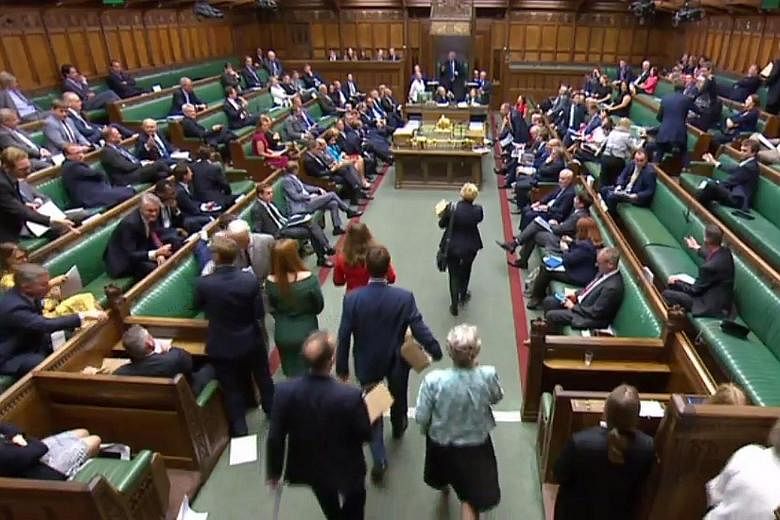LONDON • Mrs Theresa May has released the most contentious document of her two-year premiership, vowing to push through her plan to keep Britain closely tied to the European Union single market after Brexit next year.
Despite the resignation of two pro-Brexit Cabinet ministers and a growing rebellion from within her party, Mrs May published a 98-page White Paper yesterday setting out in detail the deep trading partnership Britain wants with the EU.
At its heart is a proposal for a new Britain-EU "free trade area", with interlinked customs regimes, and identical regulations for industrial goods and agri-food. While there would be "no tariffs on any goods", Britain's vast service sector will suffer significant disruption. Banks, in particular, will lose their current access to the EU market, as the government gives up on its earlier plan for both sides to recognise each other's regulations.
Mrs May faces a huge task trying to persuade EU negotiators to accept that the proposals are viable, while also keeping her Conservative party and Parliament on her side.
Time is running out to reach an exit agreement by the self-imposed October deadline.
Mrs May appealed to European negotiators to "engage" with her blueprint in the same spirit of respect that she said her government was taking towards the EU's own principles and red lines.
-
KEY POINTS IN THE PLAN
-
1 TRADE IN GOODS
Britain and the EU would maintain a "common rulebook" for goods to ensure smooth trade, including in agricultural, food and fisheries products.
In eliminating tariffs, quotas and rules-of-origin requirements, it would protect supply chains that criss-cross the EU and just-in-time processes vital to, for example, the automotive industry.
It would also avoid border checks between British Northern Ireland and EU member Ireland.
Britain and the EU would agree to any new rules through joint technical committees, and Parliament would reserve the right to reject them while accepting consequences for market access.
2 FINANCIAL SERVICES
Around £1.4 trillion (S$2.5 trillion) of assets are managed in Britain for European clients, the government's "white paper" notes, and London hosts most of the EU's trading for banks and insurance companies. The paper concedes that these firms will lose their "passporting" rights to operate freely across the EU once Britain exits the single market.
But it also says that because of the deep cross-Channel links, "equivalence" is not good enough either. That refers to special bilateral arrangements already used by financial firms from Wall Street, Japan and China, whereby they agree to meet EU rules to keep access to the common market.
Therefore, it calls for a hybrid arrangement that would adopt equivalence but also recognise "extensive supervisory cooperation and regulatory dialogue" between Britain's financial watchdogs and their EU counterparts.
3 EUROPEAN COURT
The EU and Britain would establish a political governing body and an official-level technical committee to oversee the deal.
Direct jurisdiction of the European Court of Justice would end, with all disagreements enforced in Britain by British courts, although they would pay "due regard" to EU case law. Both sides would need to agree a means of resolving disputes, including through binding independent arbitration.
4 MIGRATION
Britain would end free movement of people from the EU, and Parliament would decide on any future immigration plans, but would seek reciprocal "mobility arrangements" with the bloc.
It wants to support businesses to move staff between the two territories, allow mobility for students and young people, and allow citizens to travel without visas for tourism and temporary business activity.
Any deal should also include arrangements ensuring that Britons retiring to EU countries have access to their pensions and healthcare.
5 SECURITY
Britain wants a new treaty allowing it to continue using EU internal security measures, such as the European Arrest Warrant, and to participate in agencies such as Europol. It also proposes cooperation on external security, such as sanctions.
AGENCE FRANCE-PRESSE
"Our proposal is comprehensive. It is ambitious. And it strikes the balance we need - between rights and obligations," Mrs May wrote in the foreword to the White Paper.
"It would deliver a principled and practical Brexit that is in our national interest, and the UK's and the EU's mutual interest."
Britain has also set out a complicated structure for supervision of the new relationship that would allow the two sides to discuss rule tweaks and include a mechanism for solving disputes.
The British Prime Minister, European leaders and ministers would establish a "governing body" to set the direction of the future relationship, while a joint committee of officials would provide the day-to-day running of the agreement.
Crucially, in a move that could anger Brexiters, if there is a dispute over the interpretation of EU rules that Britain has agreed to adhere to, the European Court of Justice could have the final say.
Details in the document include: Britain will mirror EU rules for goods, as well as collecting tariffs on behalf of the bloc. In a sign of the imbalance in the relationship, Mrs May is not proposing the EU collect tariffs on behalf of Britain.
Britain proposes setting up new arrangements to allow it to have a voice - but not a vote - when the EU introduces new regulations, and to facilitate the customs arrangement.
On immigration, the document says Britain will continue to be "open and tolerant", while ending the free movement of people. It stops short of saying EU citizens will be prioritised in any future immigration system.
EU chief Brexit negotiator Michel Barnier, who will be meeting Brexit Minister Dominic Raab next week, gave no immediate view on the merits of the British plan.
BLOOMBERG
SEE EDITORIAL

